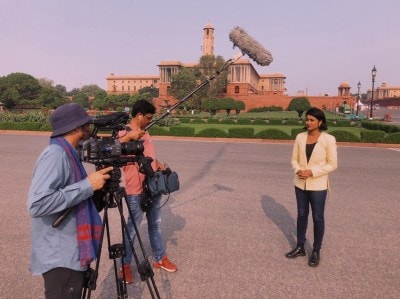- India
- International
Digital technologies: Able tools need varied application
Payment Bridge (APB), backing government’s claim of the immense utility of this system in combating frauds.
 Aadhaar and its derivatives, may not be enough in ensuring that the country fully utilises these technologies for the purpose of better governance. (Illustration: C R Sasikumar)
Aadhaar and its derivatives, may not be enough in ensuring that the country fully utilises these technologies for the purpose of better governance. (Illustration: C R Sasikumar)
The NDA government may have redoubled the focus on leveraging technological platforms and systems under its flagship Digital India programme, but the mere presence of these tools and systems, including
Aadhaar and its derivatives, may not be enough in ensuring that the country fully utilises these technologies for the purpose of better governance.
“There are world class technological tools available in India such as Aadhaar, which can be applied in many ways to make services seamless, but India has not been able to completely leverage these tools available with it,” chairman of Telecom Regulatory Authority of India RS Sharma, who has also been the director general of the Unique Identification Authority of India and was also a former IT secretary, said. Speaking to The Indian Express, Sharma said that these tools could be used not just for making government services easy to use for people, but could also be applied in several other sectors such as health, education, financial services, etc.
A closer look at the progress on the practical applications of Aadhaar reveal the gaps in leveraging the technological intervention. Rampant delays in payments across states under the Centre’s job-guarantee scheme — the Mahatma Gandhi National Rural Employment Guarantee Act — offer some evidence of the shortfall in utilisation of bank accounts seeded with the Aadhaar database. Across a number of states, especially Chhattisgarh, Bihar, Jammu and Kashmir, Uttar Pradesh and Tamil Nadu, the percentage of delayed payments surge well beyond 60 per cent, pushing up the national average to over 44 per cent during the April-July period this fiscal.
Out of a total base of 12.98 crore job cards being issued, as per latest available data, 8.05 crore were seeded with Aadhaar. However, in the last two years, only 6.61 crore MNREGA transactions were made over the Aadhaar Payment Bridge. The Aadhaar Payment Bridge System is a repository of Aadhaar numbers linked with the primary bank account number of holders. The system is used for receiving various social security and entitlement payments such as MNREGA wages, pensions, etc. from government agencies.

Furthermore, according to latest available government data, only 12.02 crore, or just about 50 per cent of the bank accounts opened under the Pradhan Mantri Jan Dhan Yojana were linked to an Aadhaar number. This is despite Aadhaar being the primary ‘Know Your Customer’ (KYC) document for opening an account under the government’s financial inclusion scheme. Compared with this, total number of bank accounts that have been opened using electronic-KYC is a meagre 2.91 crore as of August-end.
Even as Sharma’s idea that “transferring money should be as easy as making a phone call” has the necessary apparatus available to make it happen, the laggardness in involving the available tools has proven to be a hurdle for improvement in quality of life on these grounds. On one hand, while the Centre is taking its time with applying the available systems, the private sector has grabbed the opportunity to use technology for simplifying its services. Barely a week after the Department of Telecommunications issued a notification in August, on rolling out of e-KYC-based verification for new mobile phone connections, major telecom operators such as Bharti Airtel, Vodafone India, Idea Cellular and the newly launched Reliance Jio started deploying the system that would allow consumers to activate their connections instantly based on an Aadhaar card.
Sharma said that the move would go on to save millions of rupees in cost for these telecom operators who were thus far activating connections based on a physical customer acquisition form. He added that the cost of maintaining crores of these papers was also huge for the companies. Financial technology firm Paytm also introduced Aadhaar-based e-KYC verification for its payments network, enabling instantaneous paperless verification process. Also, FreeCharge, a digital wallet owned by Snapdeal, has said it would adopt Aadhaar as a know-your-customer identity (KYC) tool for customers who can enhance their wallets to Rs 1 lakh from Rs 10,000. FreeCharge, which has around a million wallet users, has maintained that being Aadhaar-enabled is key to “mass adoption and ubiquitous usage”.
Earlier, the Trident group became the first corporate in the country to disburse salaries leveraging the Aadhaar
Payment Bridge (APB), backing government’s claim of the immense utility of this system in combating frauds. “Linking Aadhaar number to the salary accounts of the employees will help the company in saving verification cost and weed out fake data,” Rajinder Gupta, chairman of Trident group, said.
However, it isn’t that one-sided. In some cases, while the government has said it has made enough provisions in the new Aadhaar law to ensure there is no breach of privacy, the very apprehension in a certain segment of stakeholders of sharing the data with the government is stopping the optimum utilisation of the country’s identification technology. The UIDAI top-brass recently met executives of various big smartphone manufacturers to discuss the possibility of having Aadhaar integration within their devices. This would make smartphones enabled with fingerprint readers and iris scanners a tool for making seamless payments when connected with the UIDAI server. This, however, would mean the manufacturers opening up their own technology used for security and encryption to the authorities — something these companies have stood against in the past.
Must Read
Apr 23: Latest News
- 01
- 02
- 03
- 04
- 05






































